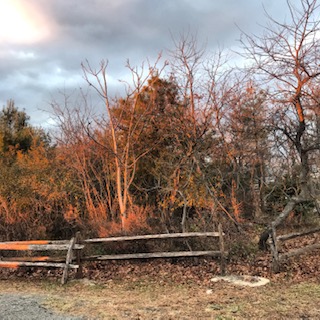Tips on Savoring the Solstice from a Jamaica Bay Park Ranger
/The sunset casts light on a trail gate at Jamaica Bay Wildlife Refuge as seen from Ranger Audrey Bartow’s office window. Photo courtesy of Audrey Bartow.
By Audrey Bartow
Special to the Eagle
What do we think of when we hear that winter has arrived? How does it make us feel?
What if we chose to think of the solstice not as a leaving of warmth, but a coming of light?
While Dec. 21 will be the longest night of the year — more than 14 hours of darkness, here in Queens — every night will get shorter after that, and every day gets longer.
If the arrival of winter brings you a feeling of dread or despair, I hope that I might be able to show you this season from another perspective. And if you already love winter, then rejoice: Dec. 21 can be a celebration.
Cathy Johnson, in her book The Nocturnal Naturalist, says “[In winter] we have to look hard for signs of life. But life there is if we take the time to see it.”
If you are a nature observer like me, you may sometimes feel frustrated by the lack of apparent wildlife in winter.
Cathy Johnson mentions this as well and she gives us some food for thought.
“In the absence of more easily achieved observations, weather itself becomes the subject,” she says.
Water presents itself in more ways in the winter. In addition to rain, we can experience winter water as frost, snow, sleet and freezing rain.
If we like, we can take time to have a more childlike appreciation. We can use all five of our senses to better observe it.
When was the last time you caught a snowflake on your tongue? Who’s stopping you? We can even make snow ice cream by mixing a bowl of fresh snow with a can of sweetened condensed milk. It’s an instant dessert and it tastes great.
Now, just because we spend more time noticing the weather doesn’t mean there isn’t wildlife to see if we look closely.
With fewer hours of daylight, and chilly temperatures, we tend to spend more time indoors. We are not alone.
Much of the wildlife of the region is also headed inside their nests and dens. It is a time to live simply and to plan for warmer months. But have we actually been looking to nature for guidance?
Let’s start with hibernation. If that’s not going inward, then I don’t know what is.
While bears may be most famous for hibernation, we’re not likely to find them around Queens.
We do, however have a few resident hibernators, including bats, woodchucks, garter snakes and box turtles. We can look to animals who insulate their homes or even themselves. Mice who gather straw and bits of string and wool to make soft, warm nests. Mammals whose fur coats get thicker — and warmer. Birds who fluff up their feathers to protect themselves from wind and chill.
In the winter, birdwatchers can spot great horned owls in Jamaica Bay Wildlife Refuge. Photo by Brendan Lally.
There are people who, like squirrels — and me — stock up on food and necessities for the winter. And there are those like most everyone — and also me — who are generally passive for a few months, trying not to expend precious energy. While all this turning in and stashing away may mean that winter animals are harder to see, there is another way that we might be able to notice them.
We can listen for them. In a calendar year in Queens., it is possible to observe eight species of owls. Jamaica Bay is no exception and winter time is the absolute best chance we have. Owls are known for being elusive, they are masters of camouflage and most often nocturnal. But when the evening comes, they give themselves away by calling out. Great horned owls have been heard calling at the Wildlife Refuge and I invite you to take a listen, if you can.
Lastly, we come to perhaps the most spectacular sight: a winter sunset.
While the palate of the landscape is mostly dull, winter sunsets more than make up for that by wildly contrasting with the grays, browns and whites. In fact, sunrise and sunset are some of the only chances we have in winter to see dazzling color.
Our solstice sunset will be at 4:31 p.m. on Friday Dec. 21 and Jamaica Bay will be an incredible place to see it, should the weather hold up.
When the sun has set, and the last of the color has faded away, and we walk out into the longest night of the year, I once again turn to Cathy Johnson who said, “If I am willing to pay the price of cold extremities, and a bit of discomfort, I find a wildness in these winter nights.”
Happy solstice and welcome, winter.
Audrey Bartow is a National Park Service ranger who works at the Jamaica Bay Wildlife Refuge.





